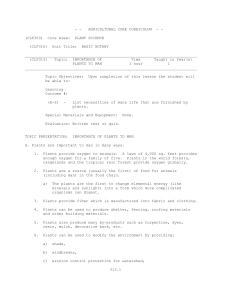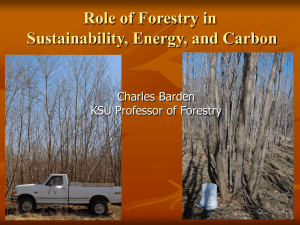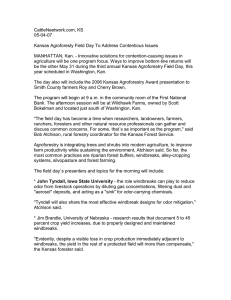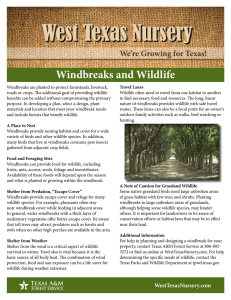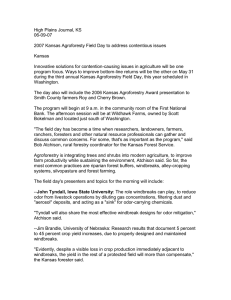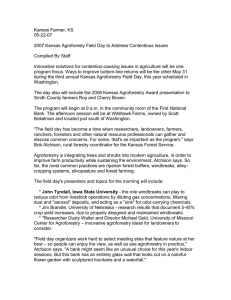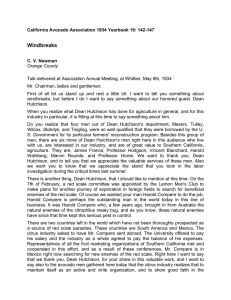An agroforestry practice
advertisement
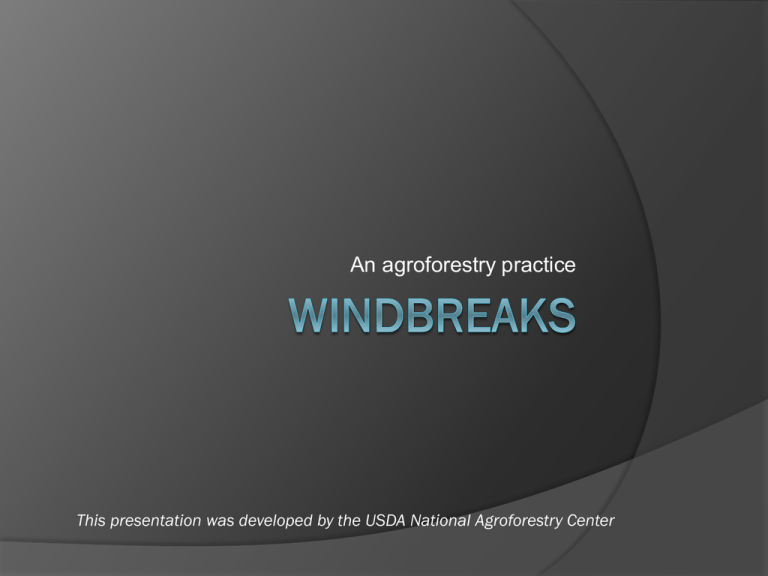
An agroforestry practice This presentation was developed by the USDA National Agroforestry Center Presentation Objectives Define windbreaks Describe the benefits and types Recognize basic design considerations Windbreaks 2 What is Agroforestry? …the intentional combining of agriculture and working trees to create sustainable farming systems. Riparian buffer Forest farming Alley cropping Silvopasture Windbreaks Windbreaks 3 What is a windbreak? Plantings of single or multiple rows of vegetation (trees, shrubs, grass) that are established for one or more environmental and economic purposes. Windbreaks 4 What are the benefits? Reduce soil erosion Protect plants Enhance plant growth Manage snow Provide shelter Reduce energy needs Improve wildlife habitat Enhance aesthetics Windbreaks Moderate noise Screen views Reduce airborne chemical drift Improve irrigation efficiency Increase carbon storage Mitigate odors 5 How does a windbreak work? Modify: Trap/filter air borne: • • • • • • • • • • Windbreaks Air flow Sound waves Odor plumes Microclimate dynamics Sediment Snow Nutrients Pesticides Pathogens VOCs 6 What are the effects? Windbreaks: lower wind velocity causing air-borne material to be deposited physically trap air-borne material adsorb some of the chemicals attached to air-borne material alter the microclimate on the downwind side of the windbreak Windbreaks 7 How can air flow patterns be modified? Modification of the wind depends upon six key windbreak features: Height Density Orientation Length Width Continuity Windbreaks 8 Why is height important? H = Effective height of the windbreak The height determines the distance of the downwind sheltered (protection) zone 10H to 15H Windbreaks H 10H to 15H 9 Why is density important? Dense: maximum wind reduction but short wind shadow Moderately dense: less wind reduction but longer wind shadow Windbreaks 10 Why is orientation important? Location or layout: Directly influences area protected Effects vary with critical weather periods and wind directions Wind Rose Windbreaks 11 Why is length important? For full protection, the windbreak needs to extend the entire length of the area needing protection to account for changing wind directions. Doubling the length of a windbreak will generally increase the area protected by 4 times Windbreak protected area Windbreaks 12 Why is width important? Width influences: Density Wildlife values Trapping capacity and efficiency Windbreaks 13 Why is continuity important? Wind speed increases in a gap Gaps in the windbreak can result in damage or complications downwind Windbreaks (% of open wind speed) 14 Types of windbreaks Windbreaks 15 Types of windbreaks: field Windbreaks 16 Types of windbreaks: farmstead Windbreaks 17 Types of windbreaks: livestock Windbreaks 18 Types of windbreaks: specialty Living Snow Fence Irrigation efficiency Dust Windbreaks Odor 19 Multi-purpose windbreaks Bio-energy feedstock Food security Wildlife Income products 20 Summary Windbreaks are an agroforestry practice Windbreaks provide multi-functional benefits Windbreaks can be designed to meet site needs and land owner objectives Windbreaks 21 For Additional Information A number of web sites are available to provide more detailed information on windbreaks. Here are a few: USDA National Agroforestry Center http://www.unl.edu/nac/windbreaks.htm The Center for Agroforestry http://www.centerforagroforestry.org/practices/wb.php Association for Temperate Agroforestry http://www.aftaweb.org/entserv1.php?page=1 USDA Natural Resources Conservation Service http://www.nrcs.usda.gov/wps/portal/nrcs/home Windbreaks 22 Acknowledgements This presentation was developed by the USDA National Agroforestry Center (NAC), Lincoln NE. NAC is a USDA partnership between the U.S. Forest Service and the Natural Resources Conservation Service. National Agroforestry Center A partnership of: "The U.S. Department of Agriculture (USDA) prohibits discrimination in all its programs and activities on the basis of race, color, national origin, age, disability, and where applicable, sex, marital status, familial status, parental status, religion, sexual orientation, genetic information, political beliefs, reprisal, or because all or part of an individual’s income is derived from any public assistance. (Not all prohibited bases apply to all programs.) Persons with disabilities who require alternative means for communication of program information (Braille, large print, audiotape, etc.) should contact USDA’s TARGET Center at 202-720-2600 (voice and TDD). To file a complaint of discrimination, write USDA, Director, Office of Civil Rights, Room 326-W, Whitten Building, 1400 Independence Avenue, SW, Washington, D.C. 20250-9410 or call (202) 720-5964 (voice and TDD). USDA is an equal opportunity provider and employer." 23
